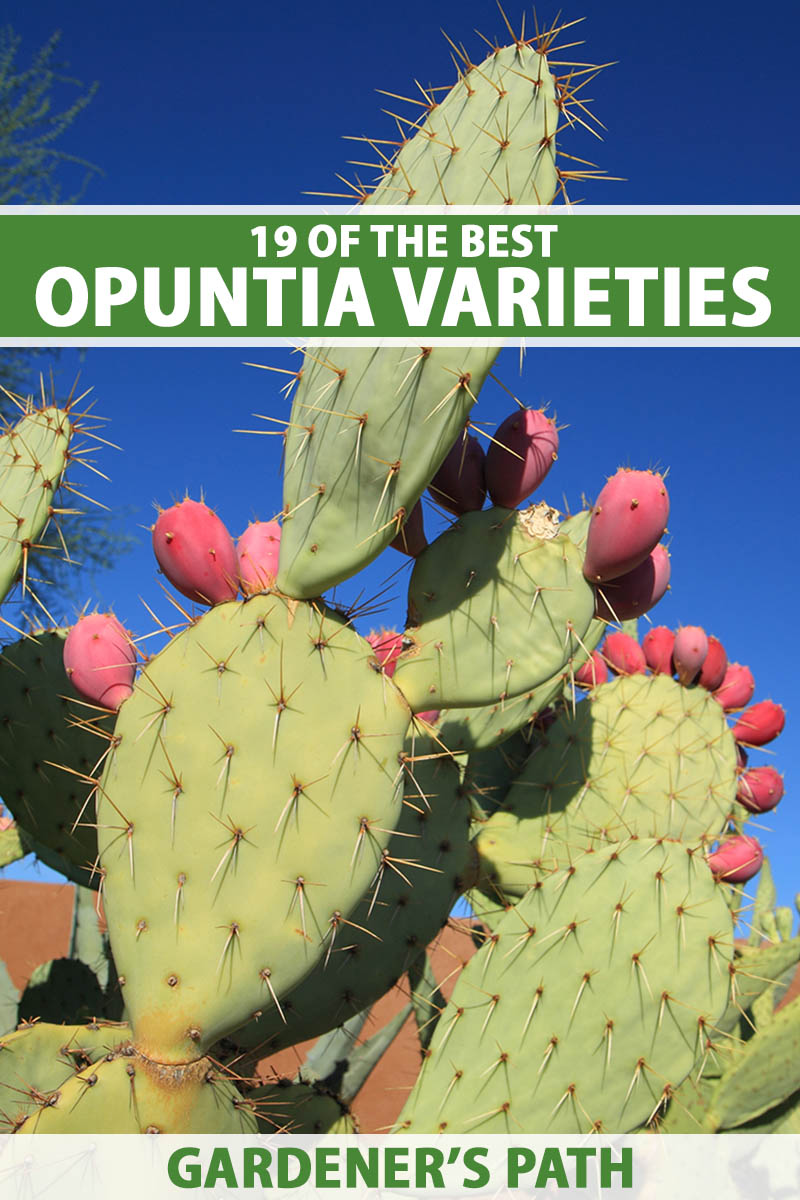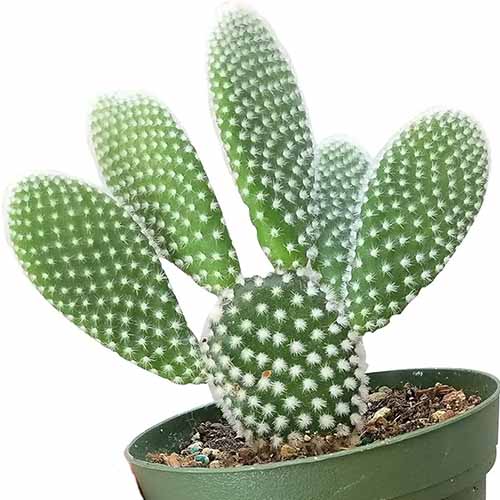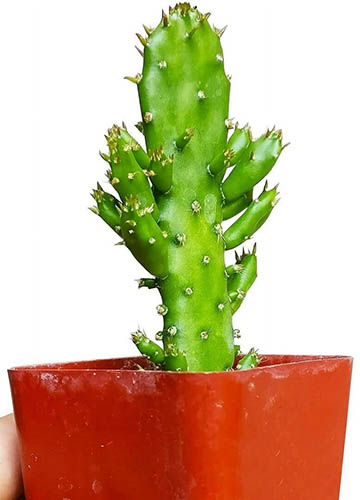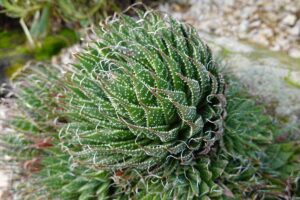Picture a prickly pear cactus, and what do you see? I bet the plant you envision has green flat pads, some spikes growing out of small lumps, and is probably a few feet tall and wide.
Sure, that describes one type, but the world of cacti in the Opuntia genus is so much more broad and varied!
Apart from the standard edible species, there are some species that grow low like ground covers, and others that tower 15 feet tall or more.
Some have green pads but you’ll also find species with pads in cream, pink, purple, gray, and blue. There are even variegated options! And we haven’t even touched on the flowers yet.

We link to vendors to help you find relevant products. If you buy from one of our links, we may earn a commission.
There are dozens of Opuntia species native to the United States and around 200 throughout the world.
If you have a dry patch in your garden with plenty of sun, there’s an Opuntia species that will suit your needs.
In our guide to growing prickly pear cactus, we discuss how to cultivate these desert species in your landscape. In this article, we’ll take a look at 19 of the best Opuntia varieties for your garden.
Here’s the lineup:
Best Opuntia Varieties
Before we chat about the best of the best, we should clarify a few terms. The big, roundish parts of the plant are known as “pads,” but they are technically called cladodes.
Cladodes are flattened stems rather than true leaves – feel free to use that info at your next trivia party!
Prickly pears can have both spines and glochids. Spines are the long, spiky bits that many of us accidentally discover when we step on or brush up against them.
Glochids are small bristle-like growths, often with fish hook-like barbs.
They kind of resemble hairs, but they sure don’t feel like it. Once they get into your skin, it’s hard to get them out. They cause pain, burning, and intense irritation.
Not all plants in the Opuntia genus have spines, but almost all have glochids.
Prickly pear pads and fruits are edible, though they vary in their palatability. If you do decide to try to eat them, always be sure to pluck any spines and burn off the glochids first.
With those terms clarified, let’s dive into 19 of the best prickly pears for your landscape.
1. Barbary
If you want to grow an edible prickly pear cactus, O. ficus-indica is a good choice.
It’s the most widely cultivated species in Mexico and usually the one you find in markets. When people say “prickly pear” or refer to “nopal,” it’s usually this species they’re talking about.
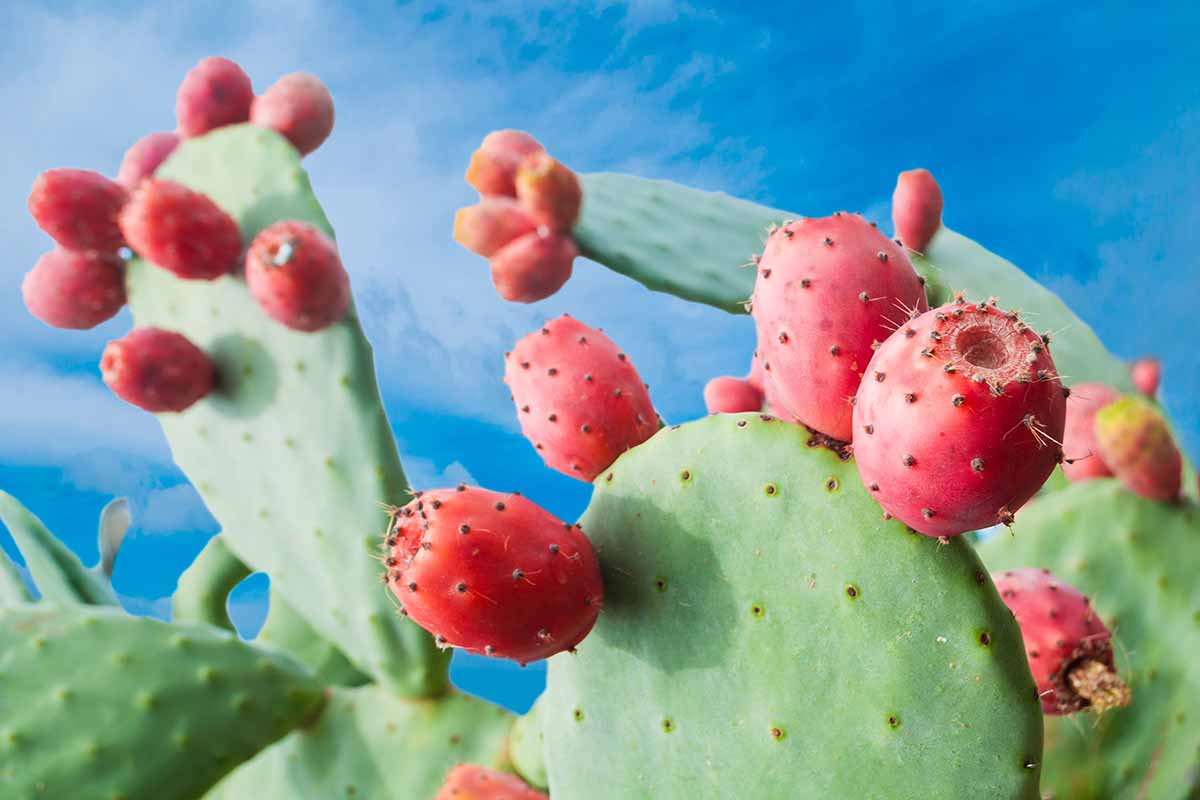
Sometimes called the Indian fig, barbary fig, or fig opuntia, it’s not only popular in Mexico but around the world as a food crop, both for the edible pads and the fruits.
It has been in cultivation for so long that experts aren’t sure precisely where it originated in the wild, but it’s thought to come from central Mexico.
It is cultivated around the world in warm, arid regions broadly equivalent to Zones 9 to 12 and has naturalized in many areas. In fact, it has even become weedy or invasive in places like Australia and parts of Africa.
When mature, this prickly pear cactus can tower over 15 feet tall and spread just as wide, and the cladodes are large and thick ranging from three to 12 inches in length.
The small white, yellow, or red blossoms are less showy than those of some species, but the fruits – called tunas – that follow are some of the best. They are sweet and juicy.
Spines may or may not be present and while the glochids are minimal, you should definitely skin the pad or burn them off before use.
2. Beavertail
The beavertail prickly pear (O. basilaris) takes its name from the gray-blue pads, which resemble the tails of beavers.
Found growing wild in the southwest US, this species reaches just over a foot tall and grows in clumps sporting hundreds of four-inch pads, spreading politely in the garden.
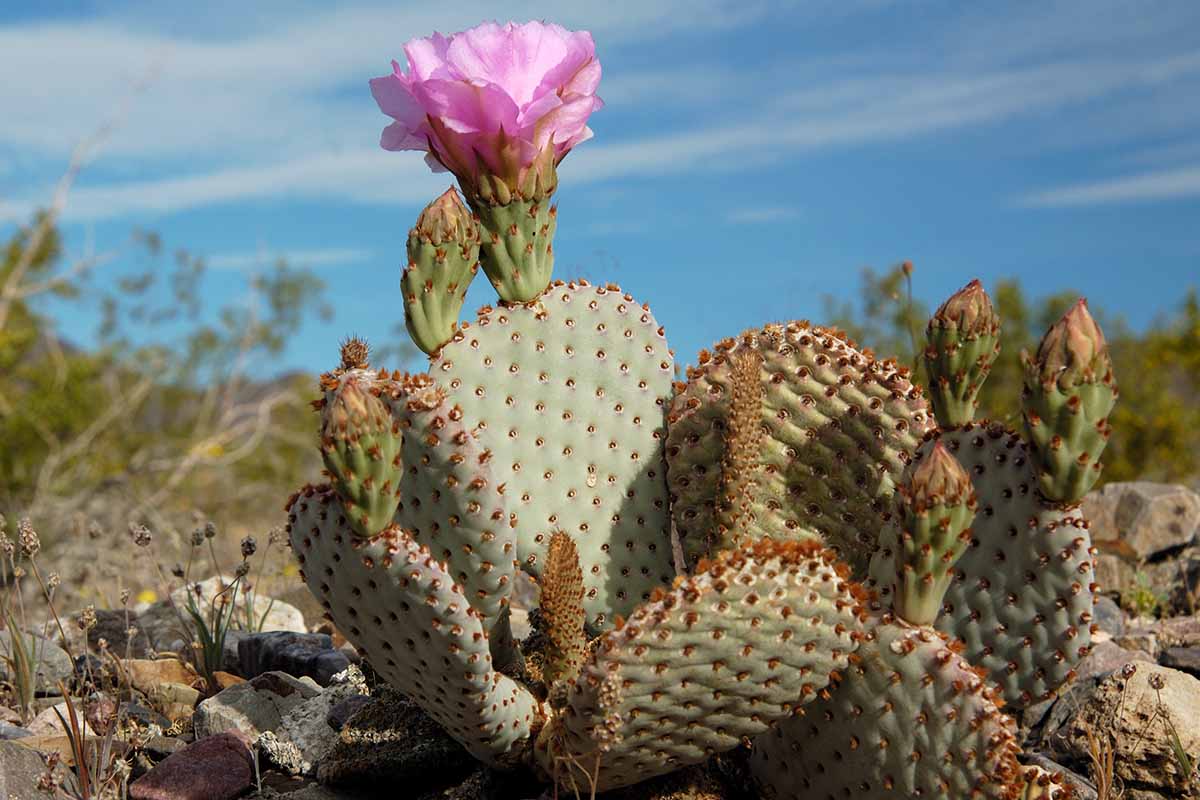
The pads might have spines, though usually they do not, but they do have glochids. The flowers steal the show featuring three-inch ruffled magenta petals with bright yellow and red filaments at the center.
The red fruits are pretty but they’re hard, rendering them largely inedible. Birds love them, though.
In cold or arid environments, the pads of this opuntia can turn purple.
3. Blind
You’ll find the blind cactus (O. rufida) growing wild in Texas and parts of Mexico, but this species is very popular in the garden because it’s spineless.

However, just because the pads are not spiny doesn’t mean they lack glochids.
The common name “blind prickly pear” refers to the fact that the glochids detach easily and can even be carried around in the wind.
Legend has it that they have blown into the eyes of humans and animals, blinding them.
For that reason, stick this statuesque prickly pear out of the way where it won’t menace passersby.
O. rufida grows up to five feet tall and wide with large, thick pads that can measure up to nine inches in diameter. The two-inch flowers are yellow or orange, followed by bright red fruits.
Grow it outdoors in Zones 8 to 10 or as a houseplant in other regions.
4. Brittle
Found growing wild across the west and midwest, brittle or little prickly pear (O. fragilis) is itty-bitty.
The pads grow to about an inch across at most, in clumps of up to a foot wide and four inches tall. They are one of the cold-hardiest Optunia species out there, growing in Zones 4 to 10.
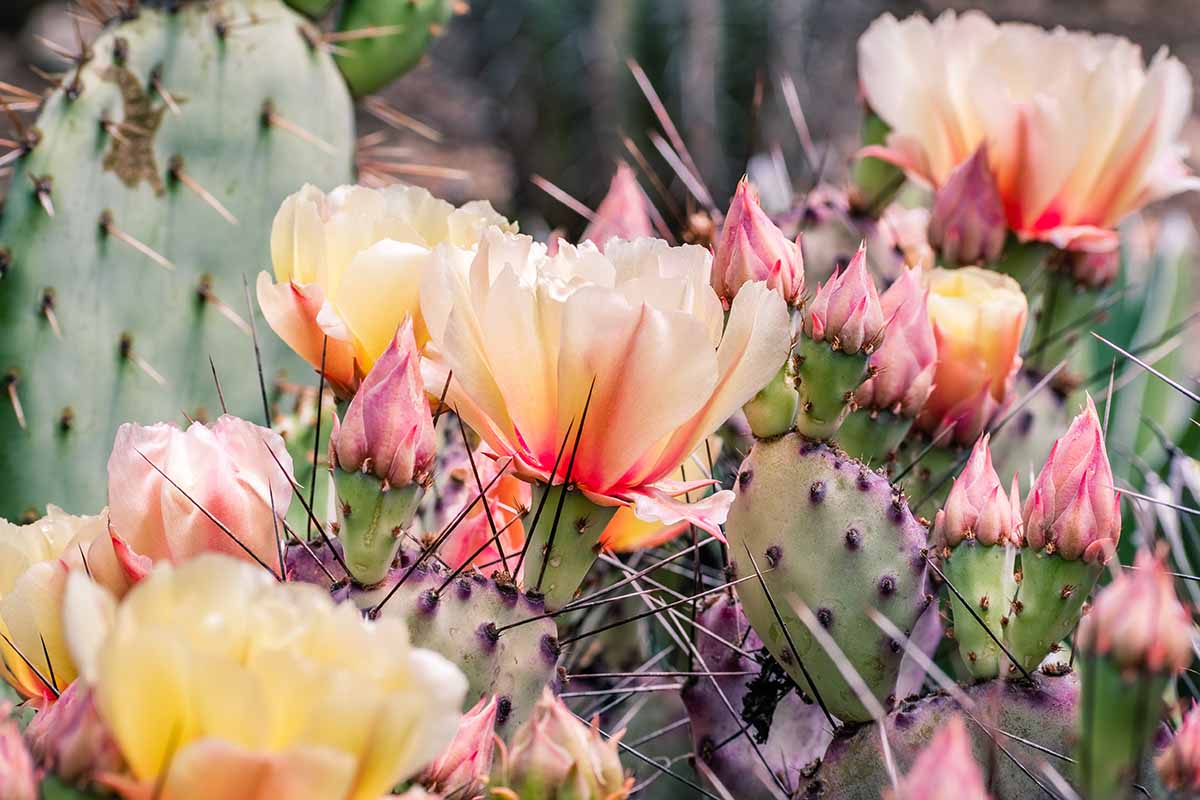
The common name “brittle” refers to the tendency of the pads to break away from the plant extremely easily, so don’t grow this somewhere it will be bumped.
This species rarely flowers and seldom produces fruits, so enjoy it for the medium green pads that form on flat chains.
When they do flower, the blossoms may be shades of pale yellow to deep pink.
5. Bunny Ears
Whether you call it angel’s wings, bunny ears, or polka-dot cactus, O. microdasys is adorable.
Growing up to about two feet tall and wide at maturity with six-inch cladodes, it maintains a manageable size. When the plant is young, it’s not hard to see the distinct rabbit-head-like shape of this Mexican native.
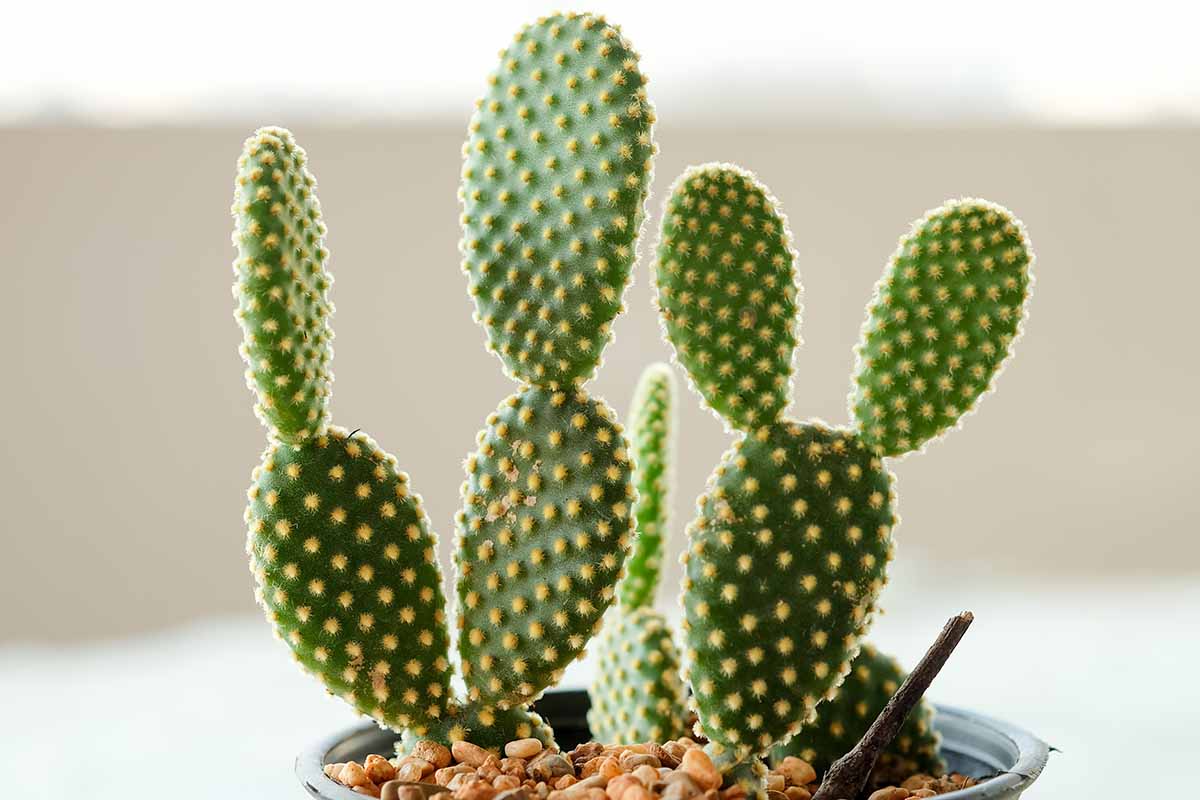
This species lacks spines, but instead, it has dense patches of yellow glochids with distinct white areoles that look like cheerful, raised polka dots.
Don’t try petting it, though. The glochids detach readily and they are a pain in the… everything.
This isn’t an option that you grow for its flowers, the pads that make this cutie stand out, and the yellow flowers only appear rarely.
Look for white bunny ears (O. microdasys albata), which has lots of fuzzy white glochids, contributing even further to the bunny-like appearance.
Pick up your own little cutie in a four-inch pot at Walmart. It’s suitable for growing outdoors in Zones 7 to 11, but many folks enjoy angel’s wings indoors in pots, where it stays smaller.
6. Desert
Across the southwest, parts of the southeast, and into Mexico grows the iconic desert prickly pear (O. engelmannii).
This species grows in clumps reaching about 11 feet tall, with round or oval pads that are about eight inches at the widest point.
The green-gray pads have spines and yellow or brown glochids, and produce bright yellow and red flowers in the spring. The juicy red fruits are extremely tasty.
This opuntia cactus prefers warmer weather in Zones 8 to 10.
7. Drooping
I prefer the alternate name of Barbary fig or cochineal prickly pear, but many people know this species as the drooping prickly pear (O. monacanthos or O. monacantha).
It’s clear how this South American native got its name – the plant takes on a tree-like form with drooping branches of ten-inch-long cladodes.
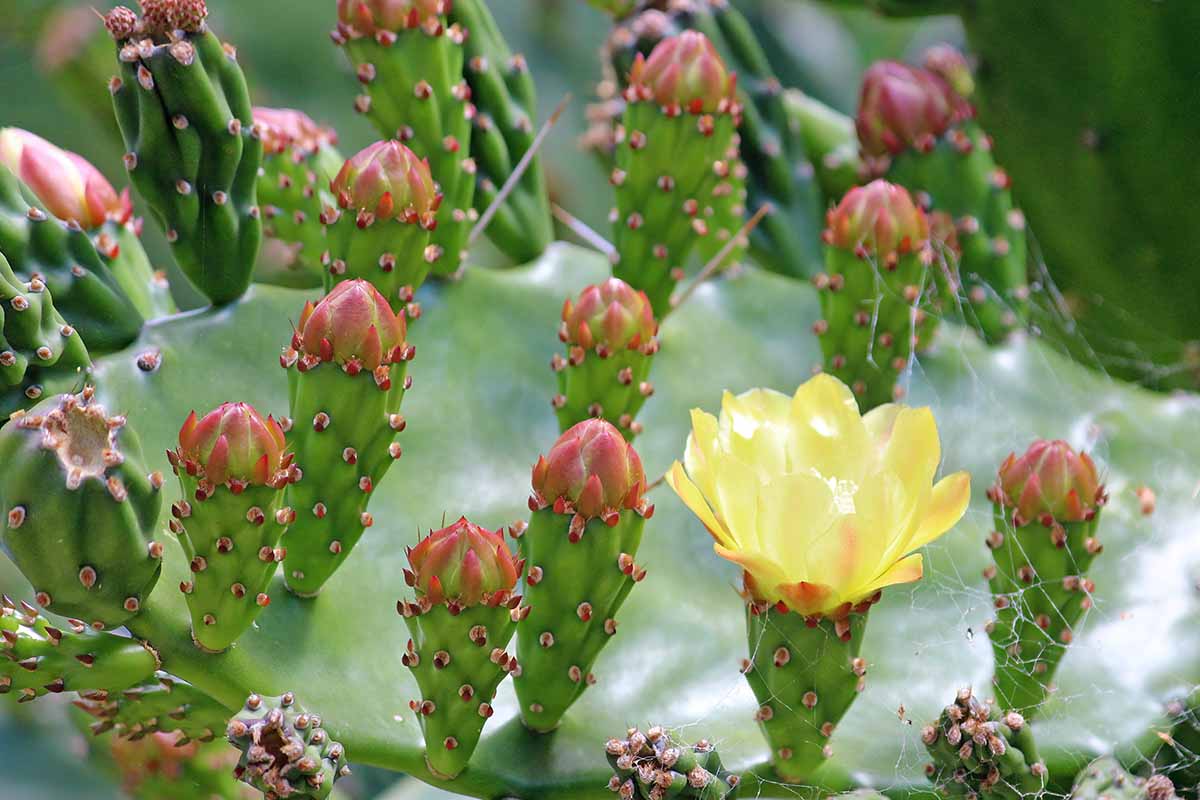
This species can grow up to 20 feet tall and about five feet wide, and when the plant is dotted with bright yellow blossoms, it really stands out.
The pretty red fruits aren’t too shabby, either. Just avoid the two-inch thorns, though not all plants have them.
This warm-weather lover can’t tolerate a freeze, so it can only be grown in Zones 9 to 11.
There are several cultivars and varieties that are even more exceptional than the species. ‘Joseph’s Coat,’ for instance, has pink, cream, and green variegated pads.
You can find live plants in two-inch pots available at Walmart. Don’t worry, it grows pretty quickly and you’ll be enjoying its full glory in no time.
8. Dune
Does this opuntia really grow in sand dunes? You betcha! Dune prickly pear (O. drummondii) inhabits the sandy dunes of the Atlantic coast south of North Carolina.
It has short spines and is often first discovered by beachgoers when they suddenly find their bare feet impaled on a rogue pad.
That’s because the small pads, which are generally just a few inches across, detach from the plant easily and take root readily, so they can be scattered and hard to see across their native range.
A mature plant can grow up to three feet tall and wide with clusters of pads.
The dune prickly pear is a bit more noticeable when the bright yellow blossoms are present, and it makes a beautiful ground cover for the arid garden. Just don’t step on it.
9. Eastern
O. humifusa (formerly O. comressa) sometimes goes by devil’s tongue or eastern prickly pear and can be found in the southeastern US and Mexico in USDA Hardiness Zones 5 to 9.
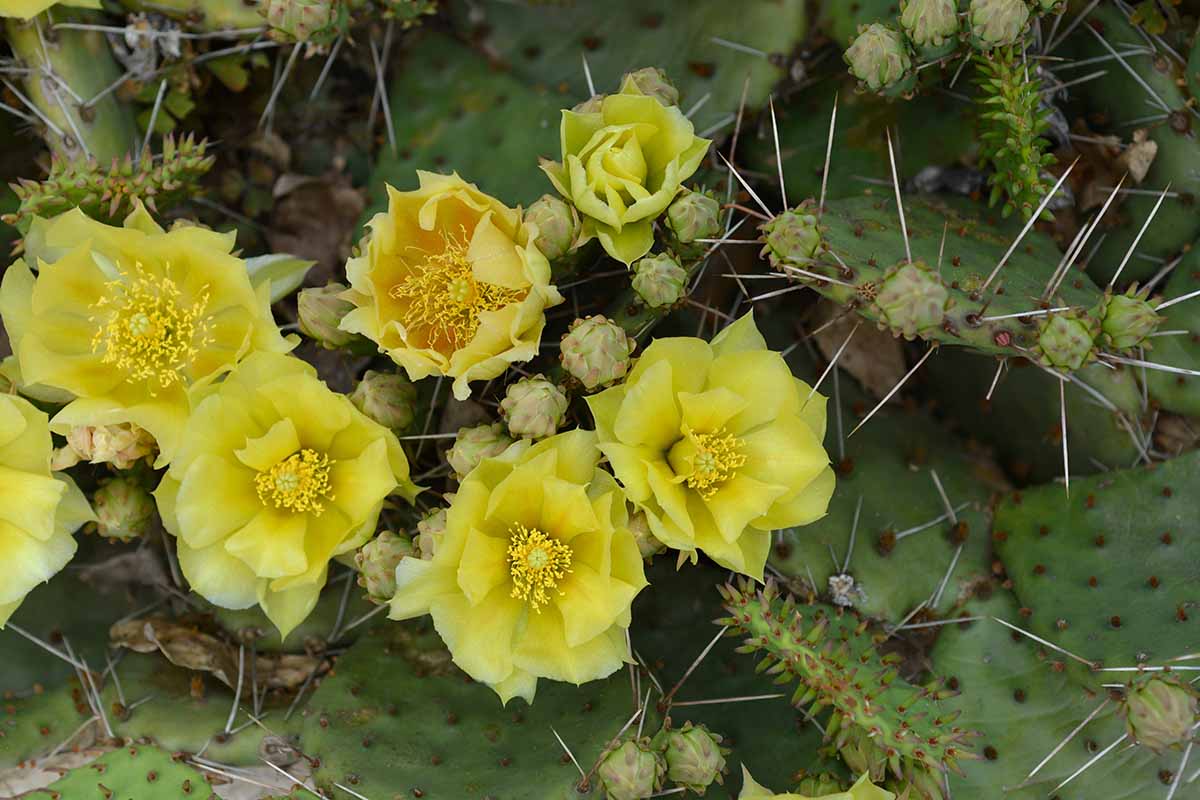
It grows a little over a foot tall and twice as wide with large oval green pads that can vary between two inches to nearly a foot long.
The showy, three-inch flowers are bright yellow, sometimes with a hint of red. The red fruits are juicy, flavorful, and delicious.
Watch out for the long, vicious spines of this opuntia, it has a lot of them!
10. Golden
Golden prickly pear (O. aurea) is a species that should top your must-have list.
It’s native to southwestern Utah and northwest Arizona, where it grows in scrublands and desert forests along with junipers and pinyon pines in Zones 4b to 10a.

In the garden, it stands out with brilliant pink, magenta, or yellow blossoms that can reach up to three inches across on nearly spineless, grayish-green pads.
The pads are fairly small, at about six inches in diameter, but there are lots of them in each clump and their size really increases the impact of the flowers in comparison. The fruits that follow are grayish-red.
This species is low-growing, reaching up to three feet wide and just a foot tall.
Look for forms that turn purple in the winter or for one of the many beautiful hybrids bred using this species as a parent, such as ‘Orange Chiffon’ with its gorgeous ruffled orange blossoms that resemble roses.
11. Isla Magdelena
Isla Magdelena prickly pear (O. pycnantha) only grows wild on the Isla Magdelena and Isla Santa Margarita in Baja California in the equivalent of Zones 9b to 11b.
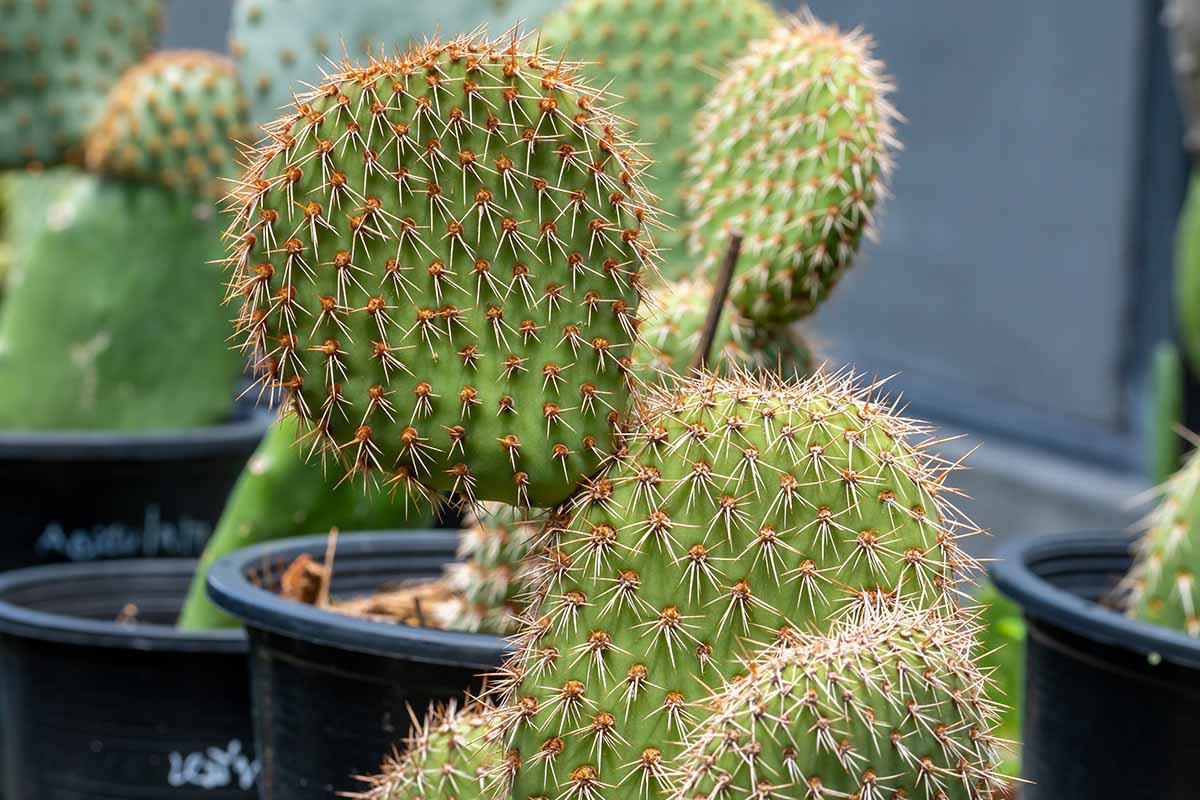
It grows slowly to a mature stature of about three feet tall and an equal or slightly wider spread, with six-inch-wide cladodes covered in pinkish-orange areolas and lots of densely clustered glochids.
The spines also appear in clusters and are short, making them look like little starbursts. The three inch flowers are neon yellow, followed by reddish purple fruits.
This one can be a little bit hard to find.
12. Marble
The circular, yellow-green, six-inch pads of O. strigil are covered in a large number of spines, with up to 10 emerging in a starburst shape from each areole.
In the spring, the plant has creamy yellow blossoms that may or may not have orange accents.
This species can only be found growing wild in Texas, but it’s popular in gardens in Zones 6b to 10b. It can grow about three and a half feet high with a similar or slightly wider spread.
Curious about how this species got its common name? It’s from the small, round, red fruits that strongly resemble marbles.
13. Old Man’s Whiskers
Native to Texas and northern Mexico, O. aciculata goes by old man’s whiskers and cowboy’s red whiskers. The common names come from the orange to dark red glochids that form in clusters. The inch-long spines might be present, but not always.
The plant grows up to three feet tall and twice as wide, with clusters of eight-inch oval cladodes. When the weather turns cold, these blue-green pads turn pink or purple.
In the spring, the pads sport three-inch flowers in yellow, apricot, orange, vermillion, or a combination of colors. After the frilly blossoms fade, the delicious red fruits form.
Grow this exceptional, slow-growing prickly pear in Zones 8 to 12.
14. Plains
If you live or travel much in the midwest, you’re probably going to come across the plains, prairie, or western prickly pear cactus (O. macrohiza). It grows wild in grasslands in its native range, but it’s popular in the garden where it fills sunny, open spots.
It can also be found in northern Mexico and parts of Idaho, Utah, Arizona, and New Mexico in Zones 7b to 11b.
The plains prickly pear is a petite queen that doesn’t grow over a foot tall, but will spread five feet wide with clumps of blue-green pads that can be up to five inches tall and four inches wide.
The showy, three-inch flowers are yellow and red, and are followed by red fruits.
The fruits on this plant are some of the tastiest in the genus, with a juicy texture and fruity flavor. The spines can be over two inches long.
15. Purple
The purple prickly pear (O. azurea) is an eye-catching species. It forms large clusters of six-inch-wide bluish pads on a plant that can grow up to three feet tall and twice as wide.
The common name comes from the deep purple hue that the cladodes take on during cold weather. Young pads emerge as bright pink.
In the spring, it forms bright yellow flowers with red centers. Just imagine the contrast with the purple tone. After they fade, purple-red fruits develop. All along, the plant is accented by long, red spines held singly in each areole.
Hailing from Texas and northern Mexico, there are at least five naturally-occuring varieties and several cultivars, so you might find specimens that grow larger or have differently-colored spines.
This opuntia is fairly cold-tolerant and can grow in Zones 6 to 10.
16. Santa Rita
Santa Rita prickly pear (O. chlorotica santa-rita syn. O. santa-rita, O. violacea var. santa-rita) is a real looker.
It draws all the attention with its commanding eight-foot-tall, ten-foot-wide presence, but it’s the attractive blue-green, round pads that grow to about seven inches in diameter that really make this species stand out.

When the winter comes around the pads change to a striking, deep purple. In the spring, bright yellow flowers rim the pads, which retain their purple hue until the summer heat arrives.
It has inch-long spines and the flowers can be up to four inches in diameter.
With a little pruning or in less-than-ideal conditions, it will typically grow much smaller, but note that lack of sun means the purple won’t be as intense.
This plant is indigenous to Texas, Arizona, and New Mexico where it grows in Zones 8 to 11.
17. Texas Blue
The statuesque Texas blue prickly pear (O. cacanapa) grows in arid, hot regions in Texas and Mexico, where it can reach up to eight feet tall.
The large, oval pads are up to eight inches in diameter with a distinct blue hue, and grow in a branching habit which makes a dramatic statement.
That’s before you take into account the two-inch-long, reddish-yellow curving spines and three-inch wide ruffled, yellow flowers. The blossoms are followed by attractive purplish-red fruits.
If you think this sounds like the perfect option except for the constant danger of being stabbed repeatedly by those vicious spines, fear not – ‘Ellisiana’ is a spineless cultivar.
In addition to the lack of spines, it’s also almost devoid of glochids – one of the only prickly pears with this characteristic.
‘Ellisiana’ is suitable for cultivation in Zones 7b through 11b. The species plant is hardy in Zones 6 to 11.

The lack of glochids also makes ‘Ellisiana’ an excellent option for culinary use.
You can find cuttings available via Amazon.
18. Tulip
With its blue-green pads and clusters of yellow and red spines nestled in a bed of glochids, tulip or desert prickly pear (O. phaeacantha) is an attractive option.
When the three-inch tulip-like yellow and orange blossoms pop up it’s truly spectacular.
The red fruits are some of the tastiest, having a flavor similar to a mild pear. Add to that the fact that the pads can turn purple during dry times and this is one exceptional cactus.
This species grows to about three feet tall and wide in clumps with large pads that can be up to nine inches long. It grows throughout the southwest and Mexico in Zones 10 to 12.
19. Wheel
Wheel cactus, also known as silver dollar prickly pear (O. robusta), is named for the large, round pads, which are bluish-gray and up to 20 inches in diameter.
You could easily see them doubling as wagon wheels!
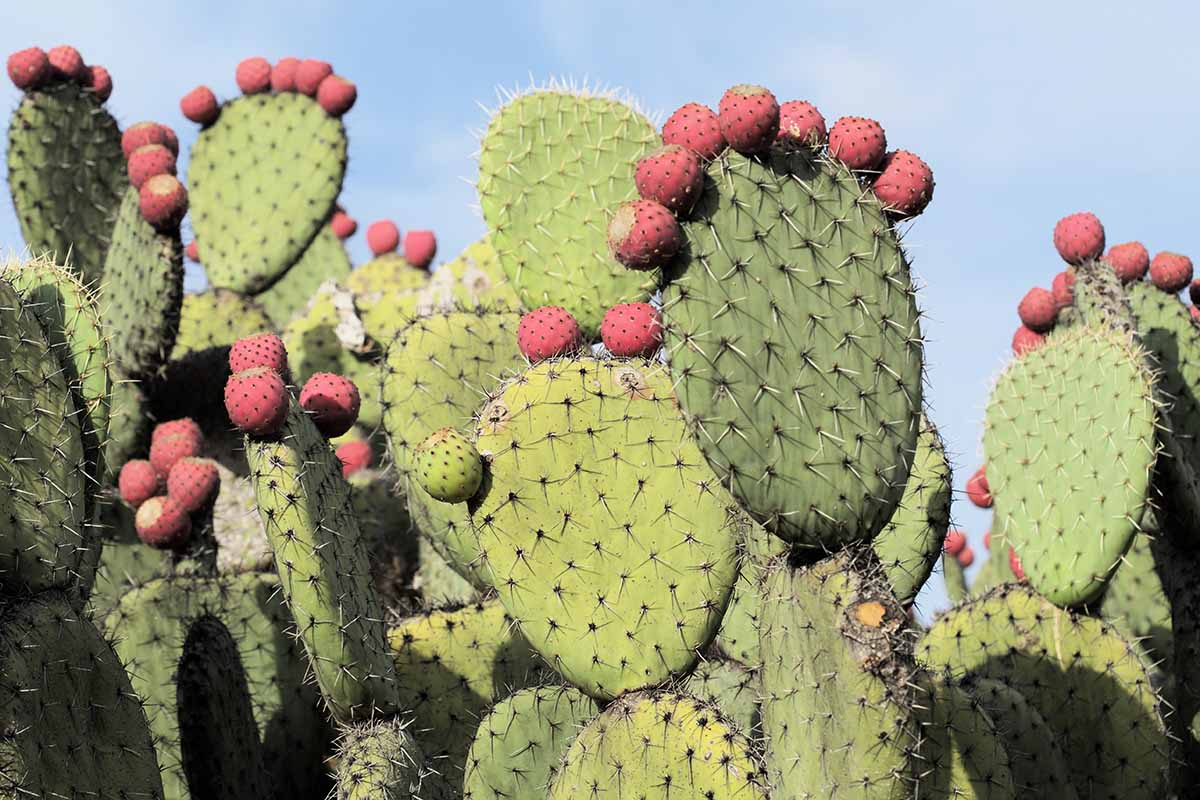
Wheel cactus is endemic to Mexico, Arizona, and New Mexico, and sports vicious two-inch-long spines. Plant it far away from walkways. There are some varieties that are spineless.
You don’t need to get up close to enjoy its display. At nearly ten feet tall with long branches of cladodes, this species can be enjoyed from afar.
That’s also true even when the yellow, three-inch blossoms are on full display. These are followed by tasty and attractive magenta fruits.
If you’re willing to offer it some support, it can grow even taller. I’ve seen these plants reach 16 feet tall!
You have to live in Zones 9 or 10 to enjoy this plant.
So Many Opuntia Opportunities
Opuntia species come in a much broader range of colors, sizes, and shapes than many gardeners realize.
Whether you’re interested in a pretty ornamental for the garden or you want your own supply of nopales and tunas, you’ve got lots of options.
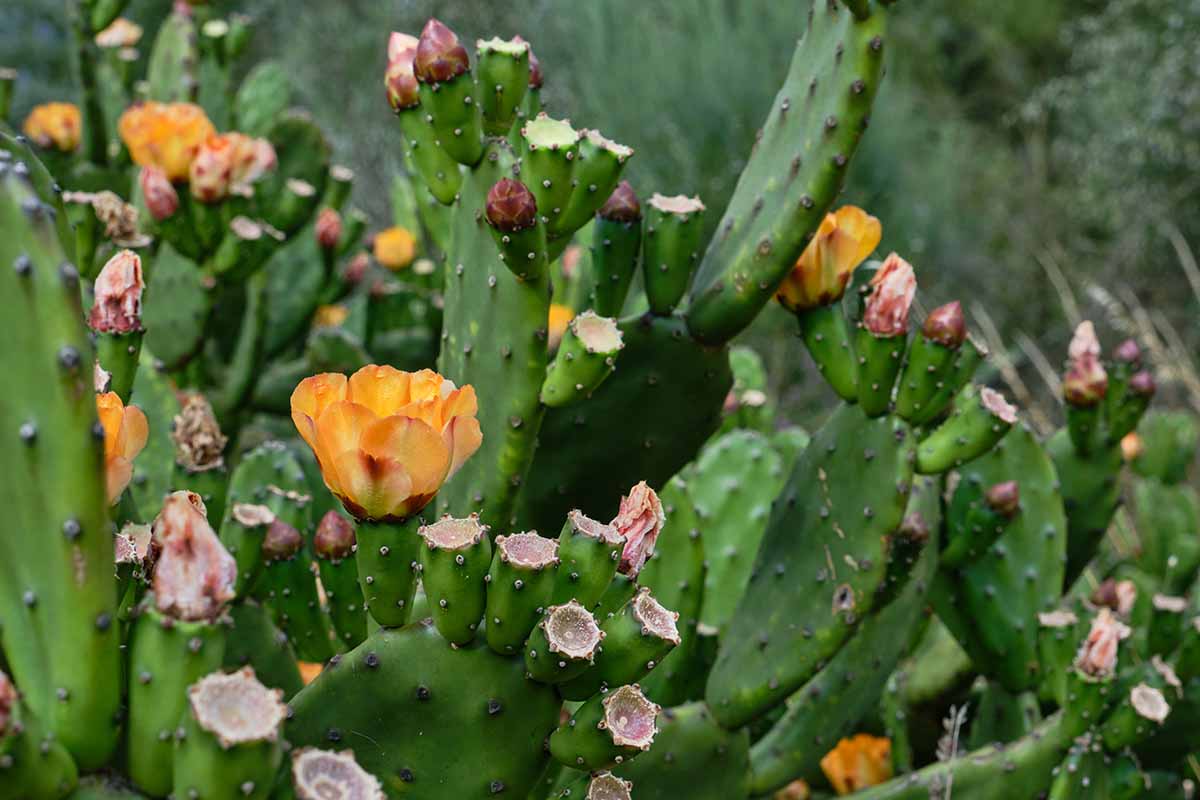
What type of prickly pear are you interested in? Which one of these is catching your fancy? Or maybe we missed one that you’re particularly fond of. Fill us in on the details in the comments section below.
And for more information about prickly pear cactus, have a read of these guides next:
